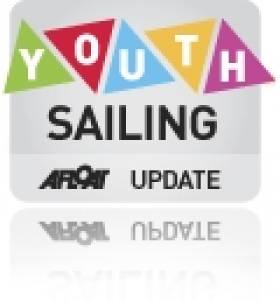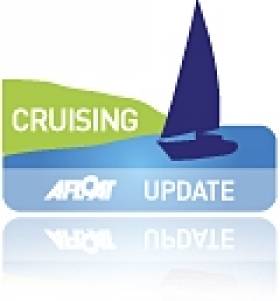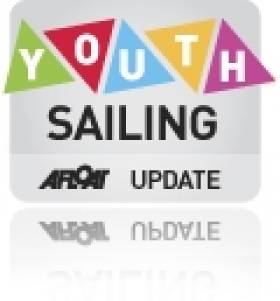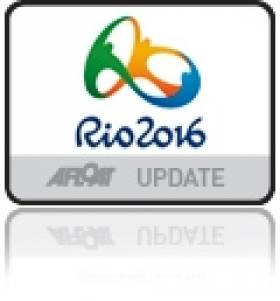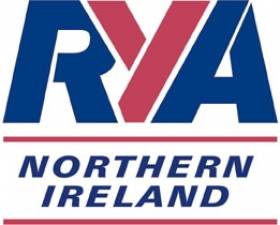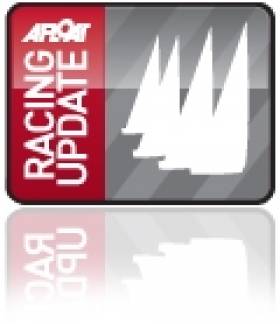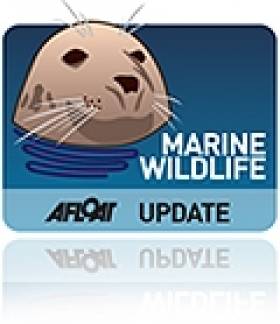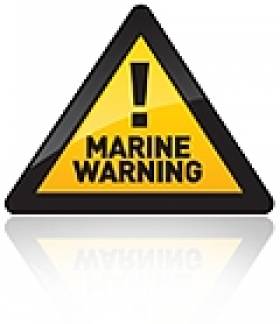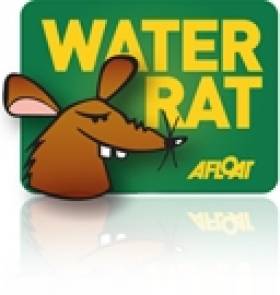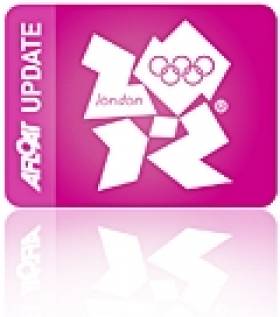Displaying items by tag: RYA
#youthsailing – Sole Irish skiff duo Sean Donnelly and Patrick Crosbie took fifth overall in a highly competitive British youth nationals fleet in Weymouth yesterday. After eight races and one discard in the week long event, the National Yacht Club pairing counted seven top ten results, inlcuding a third place in race six in a 64–boat fleet.
And in the 420 dinghy, Ewan McMahon and Colin O'Sullivan from Malahide Yacht Club were 15th overall. Club mates Lizzie and Carrie McDowell were 26th in the 44–boat fleet.
ll classes took to the water as scheduled on this final day of racing yesterday but battled against a light shifty breeze resulting in postponements and abandonments across the four course areas. The RS:X were the only class to complete a race, whilst the other four classes attempted one race, which was abandoned shortly after starting.
The RS:X boys' class was the one to watch this week as the battle for the top spot was the hot topic of conversation on the final day of racing. Entering the final day of the regatta Daniel Wilson trailed overnight leader Robert York by two points, however was unable to overcome the deficit as York clinched a second in the only race of the day to take event victory.
"It feels pretty awesome, I have put in a lot of hard work over the week so it's nice for it to pay off," expressed the 18-year-old from Skegness.
"It means a lot, I have been in the RS:X for two years now. Last year was my first Youth Nationals and it didn't really go to plan so it's nice to win it this year. I have been looking up to people for a quite a few years so it's nice to finally be there."
York found himself in third place going up the first beat with Wilson leading the race from the word go. Fighting against the light breeze inside Portland Harbour, York managed to pull himself up into second, while Wilson dropped back into third, handing York his first RYA Youth Nationals title.
"The last race didn't start off too well, I had an okay start but probably didn't go the right way up the first beat and ended up in third. Then the wind started to drop, there was a lot of pumping involved but I managed to bring it back and get past Dan [Wilson] who finished third."
Imogen Sills has completed her quest in emulating older brother Sam and twin sister Saskia by winning her first RYA Youth Nationals title in the female RS:X windsurfing event. Sills sealed championships honours with a fourth place finish overall, ending her regatta an impressive 20 points ahead of second placed Emma Wilson.
"I've finally won a Youth Nationals title," laughed the17-year-old from Launceston. "It means a lot to win and I'm just so happy. I worked hard and knew what I had to do, it feels good to keep the title within the family."
Entering today's final races with a healthy lead, Sills admits that she still had a lot to do to secure the title: "Emma [Wilson] is pretty good in light winds, so I thought if there was two races then there was a chance that she could overtake me, so I had to stay near her and work hard and keep an eye out. I didn't think I had won before the race, I wasn't taking anything to chance."
The 420 boys class was won by 2013 Youth National champion Tim Riley and his new crew James Taylor, who finished fifth at the 2013 event in Largs, Scotland with his former sailing partner. The duo who had a disappointing start to the regatta, soon came into their own posting seven top three finishes from the 12 race series to win the regatta by a comfortable 17 points. Robbie King and Ryan Orr clinched the silver medal while New Zealand's Sam Barnett and Zak Merton finished with the bronze.
Riley said: "I am relieved mostly, it was such a long day on the water especially with all the wind shifting about and I was half hopeful they would get a race in. We got one away and we were doing quite well in it then they canned it because there was no wind. I looked at my watch and noticed the time limit was over and realised I'd won it, just relief, pure relief."
On defending his Youth National title, Riley added: "It means a lot to win it for a second year, especially this year as we have had so many young competitive sailors in the 420 class really coming up and just to be able to hold them off for one week which is a long, long time in these varying conditions is a relief."
Sarah Norbury and Mari Davies took the girls 420 title holding their place as top female crew throughout the regatta. At the halfway stage of the regatta the duo really upped their game and posted three seconds giving them a sizable lead over the other 420 girls crews and placing them an impress fourth overall. Jemima Lawson and Lily Summers won silver while Olivia Mackay and Abby Goodwin (NZL) finished third.
Norbury said: "It's incredible, it feels so good to win! All the work hard has paid off and it has all come together so we are really pleased."
For the 29er title, Owen Bowerman and Morgan Peach tussled all week with 2013 Youth National champion and 2013 29er World Championship silver medallist Marcus Somerville and his crew Isaac Mchardie for the top spot but fell short by a single point, giving the Kiwi sailors their second consecutive Youth National title.
"The Kiwi's put in some great competition this week so hats off to them, it has been awesome having them here! We also have had some great British people to race against so to finish second is a massive achievement for us. It's been hard work and I am pretty proud of what we have managed to achieve" said Bowerman.
Bowerman and Peach finished top GBR boat whilst Scotland's Gilles Munro and Daniel Harris rounded their regatta off with a hard fought bronze medal. Ruth Allan and Alice Masterman were the top placed female boat finishing seventh overall, improving on their 13th place finish at the 2013 event.
Scotland's Jamie Calder claimed his first RYA Youth Nationals title in Radial fleet which saw competition become extremely tight once the qualifying series determined the Gold fleet. Having posted a set of consistent scores in the qualifying series, Calder entered the final series at the top of the pack. Facing stiff competition in a competitive Radial fleet, the Scottish sailor kept his focus and continued an impressive scoreline to claim event honours.
Ellie Cumpsty claimed victory in the Radial female fleet by an impressive 38 points. Cumpsty finished eighth overall while New Zealand's Ali Nightingale finished second female with Rhiannon Massey laying in third.
Coming in as one of the favourites, Cumpsty confessed: "If I messed it up it would be pretty disappointing for me. I managed to stay calm and exceed my expectations."
The Spitfire class was a tight affair with Weymouth duo Sam Barker and Ross McFarline and Olivier Greber and Jess Eales swapping first and second place all week. Two race wins on the penultimate day of racing was enough to give Barker and McFarline the Youth National title, while Greber and Eales were made to settle for the Under 19 crown. Brothers Oliver and James King took bronze.
James Tilley, RYA Youth Nationals Event Manager, said: "It has been a fantastic week of racing at WPNSA, on the behalf of the RYA I would like to thank the huge team of volunteers, the venue and all of the sailors for making it an excellent event."
Double Olympic gold medallist Sarah Gosling OBE, who has formed part of the RYA's Selection Panel at WPNSA this week, added: "I have been really impressed with the standard of racing this week, it's fantastic to have some foreign sailors here. The boat handling around the course has been strong and in a wide range of conditions which has been fantastic especially from a selectors point of view to see how the sailors react to different conditions.
"For those who didn't quite achieve what they set out to, they need to remember it is the first stepping stone in their journey and I think everyone needs to understand that you don't necessarily win everything you set out to, you don't always perform to the best of your ability all the time.
"It is how you overcome that, take the lessons forward and improve for the next event and this is actually what makes a great sailor. Not everyone will win everything, it's how you knuckle down after this event and assess what happened then go out and do better next time," concluded Gosling.
RYA Scotland Seek Irish Boats For Commonwealth Flotilla
It was hard to miss the big announcement of '100 days to go' for the Commonwealth Games in Glasgow this week but today it is the turn of RYA Scotland as they also reach the '100 days to go' milestone for the Commonwealth Flotilla.
As previously reported, the Commonwealth Flotilla is an official Festival 2014 event and the RYA Scotland team is delighted to be part of the Games experience for spectators and visitors. The event has really gathered pace since the formal launch at the end of February. With over 250 applications having been received already, the response of people looking to get on the water and get involved has been overwhelming.
The Commonwealth Flotilla, which will see the largest number of boats ever assembled on the Clyde, will take place over the weekend of 25-27 July 2014. The morning of Saturday 26 July 2014, the mass Flotilla will make its way on the 17 nautical mile (32km) journey from Greenock to Pacific Quay in Glasgow, adjacent to BBC Scotland and the Glasgow Science Centre. The event is the perfect way to not just promote sailing as a sport, but also to showcase Scotland as a fantastic place to visit and to go sailing.
"Our trip up the Clyde and into Glasgow at the end of July won't just be about the sail itself. If your boat isn't one of the 250 registered to take part then all is not lost as there will be lots of other chances to get involved and enjoy this spectacular opportunity" commented Claire Caffrey, RYA Scotland Marketing Officer.
The RYA Scotland Commonwealth Flotilla is actively seeking boats from England, Wales, Northern Ireland, Ireland and beyond to enter. The Flotilla is not just for Scottish boats. RYA Scotland would like to welcome and are encouraging boats from all over the UK, across Europe, the Commonwealth and beyond to join us for the event of a lifetime. Don't miss out – register before 28th April 2014.
Scotland is one of the best places in the world for sailing – challenging waters, a beautiful and dramatic coastline, intriguing history and places to visit – wrapped with a genuine warmth and hospitality along the way. Combining this with the Commonwealth Games, Homecoming Scotland, the Glasgow 2014 Cultural Programme and the Commonwealth Flotilla event means there really is no better time to visit Scotland and experience all that Scotland and the city of Glasgow has to offer.
British Youth Sailing Talent on Show at Record RYA Week
Next week will see a record number of the nation's top Youth sailors compete on the Olympic waters of Weymouth and Portland for the chance to be crowned RYA Youth National Champion 2014.
The premier event on the RYA's Youth Racing calendar, which this year is being staged at the Weymouth and Portland National Sailing Academy from 12-18 April, will welcome the largest number of competitors in the event's history.
Over 392 dinghy, catamaran and windsurf racers in the six Youth classes will compete across four race course areas in Weymouth Bay and Portland Harbour for Championship honours and the chance to be selected to represent the British Youth Sailing Team at a range of International competitions, World and European Championships in 2014.
Five reigning champions will be bidding to retain their crowns; Tim Riley (420 boys), Luke Burywood (420 boys), Olivier Greber (Spitfire) and Mimi El-Khazindar (29er) all landing their first Youth National titles in Largs, Scotland last year, while Ben Batten (29er) will be vying for his third consecutive national title at this year's event.
"Our preparations for the Youth Nationals have been going really well. Mimi and I have been sailing well together, we have been working hard over the winter and we feel like we are ready to go come the starting gun on Monday," expressed Batten.
"We would love to try and win the regatta again -- it would be an amazing achievement for us to win what is such a big and prestigious event for a second year running. Our aim is to just put in a good, consistent series and to also try and take away as much as possible for our summer regattas. We know if we sail like we know we can, keep consistent across the five days of racing then we will be in with a chance of defending our title."
17-year-old Batten, who competes with his helm Mimi El-Khazindar, will be up against it they are to retain their crown in the 29er class. The Lymington duo who represented Great Britain at the 2013 ISAF Youth Sailing World Championship will face stiff competition from 2013 Youth Nationals medallists Owen Bowerman/Morgan Peach, siblings Rob and Emma Loveridge and the Scottish duo of Gillies Munro/Daniel Harris who will be among the other main title contenders.
"It's certainly going to be a challenge in what is such a competitive 29er fleet. Every year is as tough as the last and everyone gets better each year and everyone is continually improving so it will no doubt be a very tough regatta to win. We now know the people we are up against, better than we did last year, and have had more time to train and compete against them in the build-up to this regatta so it will be interesting to see what happens.
Batten concluded: "To win the Youth Nationals for a third consecutive time would be an amazing achievement for myself. I know there is only a small handful of sailors who have managed to achieve this in the past so to be able to do win three national titles would be incredible -- it would feel like I was joining an elite club which would be great."
The 420 class looks set to be a close contest with 2013 Youth National champions Tim Riley and Luke Burywood now competing against one another in a bid to defend their crowns with their respective new teammates. 2013 ISAF Youth Worlds bronze medallist Oli Greber and new teammate Jess Eales are among the top runners in the mixed multihull Spitfire event and no doubt will be dominant in the hunt for success.
The Laser Radial is the largest fleet of the Championships boasting 106 boats. With such large numbers the fleet is set to be one of the most competitive classes with a select number of sailors possessing the racing skills required to clinch championship honours.
With two-time RYA Youth National Champion and 2012 ISAF Youth Worlds gold medallist Saskia Sills not competing due to illness, the door has been left wide open for her twin sister Imogen to steal the show in the RS:X windsurfing fleet, while Robert York, winner of the RYA Olympic Classes Spring Series event in March will be the one to beat in the 16-strong RS:X boys fleet.
HRH The Princess Royal, President of the Royal Yachting Association, will also visit the event on Thursday (17 April) to see the latest crop of talented sailors coming through the ranks.
The home of the 2012 sailing Olympic regatta, the Weymouth and Portland National Sailing Academy (WPNSA) has announced a prestigious new collaboration with the 'Andrew Simpson Sailing Foundation' (ASSF). The ASSF founded by the Academy's Director, Sir Ben Ainslie, Iain Percy OBE and Andrew's wife Leah to honour his life and legacy, will be opening the 'Andrew Simpson Sailing Centre' at the same venue where Andrew 'Bart' Simpson competed during the Olympic Games.
The Weymouth and Portland National Sailing Academy, based in Andrew's home county of Dorset, will act as a hub for all of the Andrew Simpson Sailing Foundation's activities, helping the Foundation fulfil its charitable objectives. The RYA accredited Centre will open in May 2014 offering a range of sailing courses for young people, community organisations and adults; including programmes for schools, as well as club sailors.
Peter Allam, Chief Executive at the Weymouth and Portland National Sailing Academy explains the relevance to the local community; 'the ASSF has agreed to work closely with the Academy and the Chesil Trust to deliver the 'Rod Shipley Sail for a Fiver' scheme which has to date assisted 12,000 local children to experience sailing on the waters of Portland Harbour. The scheme has run successfully for 10 years and currently introduces 1,500 children to water sports annually. The Academy is committed long term to inspiring the next generation through sailing. Working in hand with the ASSF, this relationship will make a significant contribution to the ongoing development of the Olympic and Paralympic sailing legacy here at the WPNSA'.
Amanda Simpson, Andrew's sister and a Trustee of the Andrew Simpson Sailing Foundation as well as being an accomplished sailor in her own right commented, 'this is a fantastic opportunity for ASSF to engage with grass roots sailing in a place where Andrew spent much of his youth and adult sailing life. We look forward to working with local and national communities to make this venture at the WPNSA a huge success'.
RYA's New Initiative for Cruiser Racing
National Handicap for Cruisers or NHC is the RYA's new initiative for cruiser racing which as of March 2013 has replaced the Portsmouth Yardstick for this area of racing.
The change was born through a lack data coming into the RYA via club returns. The PYS, as a true empirical scheme, relied on clubs to return data to the RYA in order to be able to analyse the performance of each boat and to be able to publish numbers which identified these performance differences. Without the data coming in from the clubs, the RYA had nothing to analyse and subsequently nothing to publish.
The decision was taken to look at alternative options in October 2012 after four successive years where cruiser returns were in decline. Luckily this decision was taken at the right time as for 2012 the RYA received only 16 returns from clubs.
Having spoken to a variety of other countries running handicap racing, the decision was taken to work with a measurement based scheme which would alleviate the requirement for club returns. This would form a base list of boats from which clubs were able to develop their racing. The other element to the scheme was to include progressive handicapping, something which has been used very successfully in Ireland under ECHO.
In order to develop the handicaps, the RYA worked very closely with the RORC Rating Office who provided invaluable advice in tweaking the handicap formula as well as supplying the data to produce the base list. The RYA were keen not to make NHC a measurement scheme and therefore concentrated on the three principle factors which would effect a boats performance - length, weight and sail area. Additional a factor was introduced based on the design age which would account for the different style of hull designs as time went on.
The other decision was to publish a single number for a boat variant irrespective of the different rigs or keels available. This decision was not taken lightly and came about after a careful review of the boat data held. It felt counterintuitive to apply a 3% adjustment for a factor when a boat could be 15% lighter than all of its sister-ships. Instead of set adjustment factors, the decision was taken to allow the boats performance, as noted by its race results to actually define how it performed.
Analysing performance, like a handicapping formula, is completely open to opinion as to which method is best. In the end the RYA looked at a variety and developed a slight hybrid in terms of performance handicapping. It based its principles on ECHO but removed the subjective element and automated the process within a number of key popular scoring programs. It provides a different adjustment factor for over achieving than under achieving against your base number and is ultimately a little softer in how adjustments are applied over a series of races - perfect for club racing on a regular basis.
The new element to NHC is the regatta version which has been entirely developed by the RYA for use at key events. Recognising that the base list will never be 100% accurate and that a regatta may not have enough time to iron out any anomalies, a harsher adjustment module was developed for regattas where adjustments for the first couple of races in a series are much higher and soften out towards then end. This means that if a base list number is out - it is adjust quicker initially to get to the boats actual performance after Race 1 and then settles down providing the performance of that boat remains consistent.
Another key part of the regatta adjustment is that a boat that does not participate within a race is taken to have placed within the top three - this was key to avoid boats turning up for a single race within an event to purely win that days trophy.
Both systems will adjust depending on how quickly it gets around the course relative to other boats in that race. This will also combine a level of personal skill as well as boat preparation - leading to the possibility that two sistership boats will have completely different handicaps. This is the intention of the scheme.
NHC has been designed as an entry level scheme to cruiser racing where if you don't have the right boat, a rail full of crew, more growth on your bottom than the Mary Rose or simply want to sail with your kids, family dog and tea bags - your handicap will adjust towards your skill level and performance. The scheme will rewards those who are consistent and the key to its success is in how much those sailors see their handicap changing as they develop their skills. Similar to golf, instead of retreating to the bar and whinging about the handicap scheme, sailors have the option of being able to brag about how much they have managed to increase their handicap by as they have got better at getting around the course.
Initial feedback has been positive and clubs that understand the nature of NHC is not to replace a top level rating scheme such as IRC but more to work alongside it in nurturing sailors skills at club level before they out-grow the scheme and move up to IRC. NHC has already been used for races after a month and every day the RYA are receiving more and more emails and calls from clubs starting up with NHC and getting their members onto the water in the most simple of methods.
Irish Race Officers Attend RYA Race Officials Conference
#rya – The RYA Race Officials Conference is fast becoming a major international event writes Irish National Judge and Umpire Gordon Davies.
This year the conference returned to Wyboston Lakes in Cambridgeshire, far from the sea but north of Watford and convenient for train and air travel and an Irish race officer delegation attended.
This biennial event continues to grow. Earlier conferences were organised for Race Officers, Judges and Umpires. In 2011, Mark-layers were invited for the first time in 2011. The 2013 edition was notable for the presence for the first time of Measurers. In all, 220 race officials attended the conference, with 21 visitors from 10 nations: Norway, Denmark, Sweden, Netherlands, Slovenia, Canada, USA, Russia and Ireland.
This year, as Ed Alcock, ISA Racing Manager explains "Members of the ISA Race Officials Advisory Group attended and contributed to 20 workshops during this conference as a means to learn from the RYA education system to the benefit of officials and sailors in Ireland."
The highlight of the event are the large number of workshops treating a wide variety of subjects. Whilst the speakers are selected for their knowledge of the subject the participants are often experts in their own right. I was somewhat surprised, for example, when called upon to speak on the rather obscure subject of umpiring radio-sailing regattas, to be faced with an audience including several well-known umpires including not only the editor in chief of the Call Books for Match Racing and Team Racing, but also the person credited with inventing team racing umpiring Also listening attentively was a multiple World Champion in several Radio-Sailing classes, who is also a National Judge!
Chairman of the RO Advisory Group Jack Roy, who worked with many of the top British race officials before and during the Olympics revealed the reasoning behind this delegation: " It is important we have a close working relationship with our neighbours in the RYA, they are very generous with help and information. Having recently been responsible for, arguably the best Olympic Sailing Regatta ever, the RYA have first hand experience in providing the highest level of Race Management " Mike O'Connor added "It was great to work with such high level participation from the UK and around Europe on delivering unified race management and applying the new updates to the racing rules across different disciplines".
Bill O'Hara, fully recovered after his summer spent with the Russian Women's match racing team at the Olympics ran a workshop on "Raising Tactical Awareness for Umpires" Bill gave full credit to Chris Watts, RYA Race Officials Education Officer "The conference was incredibly well organised". Bill particularly appreciated the session on "Questioning Skills" run by John Sturrock, more accustomed to improving the interrogation skills of leading lawyers and parliamentarians, including members of Oireachtas. Bill O'Hara was one of several race officials from Northern Ireland to attend, including Robin Gray and Denis Todd.
Irish team racers will undoubtedly be pleased to hear that Peter Price was awarded the status of RYA Umpire Emeritus. Peter, from West Kirby, sailed and won the Wilson Trophy many times, and then ,in 1987, lead the first umpire team to officiate at the event. Peter has sailed many times in Ireland, both in team racing and in his Dragon, and has umpired at many events here.
Ed Alcock reminds us that the Irish participation at the conference will benefit local race officials "The ISA Annual Conference on March 2nd will include interesting points from these workshops in presentations from Jack Roy, Michael O'Connor and Ed Alcock in the areas of Race Management, rules issues in clubs and the new rules, including launching the new Racing Rule Book for 2013-2016.We would recommend all ISA officials and clubs to be present and look forward to receiving visitors from the RYA."
Presentations made at many of these workshops are available on the RYA website.
RYA 'Encouraged' By Britain's Moves On Marine Conservation Zones
#RYA - The Royal Yachting Association (RYA) has said it is "encouraged" by the British government's approach to designating Marine Conservations Zones (MCZs) around the coastlines of England and Wales - the details of which have disappointed environmental groups.
RYA planning and environment advisor Caroline Price commented: “The phased approach that government is proposing appears on the face of it to be very sensible.
“The RYA has been resolute in insisting that an MCZ should be no larger than required to protect the habitats and wildlife features which it is intended to protect and that the scientific basis for designating a particular feature for protection should be sound.
“We are pleased therefore to see that ministers have recognised that they need to have a strong evidence base when looking to designate sites, from both an ecological and socio-economic perspective.
“We are particularly encouraged that the approach to highly protected sites is being reviewed as the proposals for Reference Areas are of great concern to us.”
Of the 31 sites proposed in the consultation for designation by the end of 2013, the RYA has objections to only one of the sites - the Aln Estuary, which contains "a small charted anchorage in the one location in which a vessel can stay afloat at all states of the tide in the estuary".
The response from the RYA comes just days after environmental groups in the UK expressed their dismay over the government's decision to designate just a quarter of the recommended 127 sites.
As the Guardian reports, Westminster was accused of a "lack of ambition" by the Marine Conservation Society (MCS) over the announcement last Thursday 13 December, which it says ignores the government's own advisers who recommend a 'coherent network' that includes immediate designation for 59 sites regarded as 'highly threatened'.
The RYA says it is "broadly supportive of government plans to establish a coherent network of Marine Protected Areas and Marine Conservation Zones.
"However, it has fought throughout the process to date, and will continue to do so, to protect the public right of navigation and to ensure, as far as is possible, that recreational boating interests are not adversely affected by the designation of such MCZs."
It also emphasises that the "omission of the detail of management measures from this [public] consultation means that we still don’t really know what designation will actually mean" to affected local communities.
Wind Farm Rock Berms Pose a Hazard for Boaters Says RYA
#MARINE WARNING - As wind farm projects expand around the coasts of the UK and Ireland, the Royal Yachting Association (RYA) has raised concerns about an unexpected hazard for boaters navigating near such installations.
Taking the London Array and Kentish Flats wind farm areas in South East England as a case study, the RYA explains how rock placements, or rock berms, have been put in place to protect the power cables from these arrays at the points where they cross in shallow water.
The RYA warns that as cable crossing become more likely and more frequent, as offshore energy projects expand around the coastline, the potential for accidents is greatly increased.
"It is this cable protection that in shallow waters can reduce underwater clearance and therefore pose a risk to navigational safety," said the RYA.
Referring to the London Array and Kentish Flats specifically, the association said it "was not aware that the cables would have rock protection until we received a notice.
"It would seem that the Marine Management Organisation, Trinity House and the Maritime and Coastguard Agency were also unaware that the developers were placing a rock berm in [the[ area and are investigating how all this happened 'sight unseen' - particularly as it seemed that the original London Array Limited applications had stated that the cables would be trenched."
The RYA has more on the story HERE.
Should Ben Ainslie Land in Hot Water?
#BEN AINSLIE – As Britain's sailing superstar awaits a hearing with the Royal Yachting Association (RYA) over the incident at the World Championships in Perth last December, the consensus in the electronic media is that he has been hard done by and blame should be attributed to the media boat that caused the wash that was at the centre of the row. While quite a few of the commentators believe that the two race disqualification for gross misconduct that cost Ben Ainslie the World Championship is more than adequate punishment, Water Rat sees some similarities with soccer star Eric Cantona's transgression in 1994 that resulted in 120 hours community service and an 8 month ban from the sport.
To re-cap, Cantona was sent off in a Manchester United v Crystal Palace game for a kick on a Palace defender. As he reached the sideline Cantona launched himself into the stands and kicked a supporter in a kung-fu style following up with a series of punches. Cantona was arrested and convicted for assault, but the original two week sentence was overturned and replaced by 120 hours of community service. His team, Manchester United, suspended Cantona for the remaining four months of the season and he was fined £20,000. The Football Association increased the ban to eight months and fined him a further £10,000. Football's International body, FIFA confirmed the suspension as worldwide. Cantona also lost the captaincy of the French team.
The International Jury found as fact that Ainslie had committed an act of physical aggression, that was not only a gross breach of good manners but also brought the sport into disrepute.
The Football Association's statement is worth quoting: 'The members of the FA Commission are satisfied that the actions of Eric Cantona following his sending-off at Crystal Palace in the Manchester United match on January 25 brought the game into disrepute. Eric Cantona has therefore been in breach of FA rules. After taking into consideration the previous misconduct of Eric Cantona, the provocation he suffered, the prompt action taken by Manchester United, Eric Cantona's expression of regret to the Commission, the apologies he conveyed to those affected and the assurances he gave to his future conduct, the members of the Commission decided that Eric Cantona should be suspended forthwith from all football activities up to and including 30th September 1995 and in addition fined £10,000.'
It is worth noting that Ainslie also apologised, but his reaction to the Jury's decision was to criticise their reaction. RYA's Olympic Manager also denied that an assault occurred.
Respected sailor, sailing author, judge and America's Cup umpire Brad Dellenbaugh commented: "It's interesting to see the spin, particularly from the RYA. While not condoning Ainslie's actions, it seems they are trying to lay this at the feet of ISAF for inappropriately trialing new television initiatives at the Worlds, then at that feet of the Jury for not letting the Championship be determined by the sailors on the water. The chance to win his sixth Worlds was taken away from him.
What fails to get mentioned is that he WAS winning the Worlds despite getting screwed by the wake. Stay in his boat; win the Worlds. The reason he didn't win the Worlds is because he couldn't control his anger and he boarded another boat. Period! I wonder how Elvstrom would have reacted."
The RYA Tribunal will now consider the incident and the sailing world will be fascinated to see how they deal with Ainslie. RYA's own guidance to Race Officers rates physical or threatened violence as 4-5 on a scale of 1-5.
Despite the apparent overwhelming sympathy it is difficult to see how RYA can avoid further sanction in this case. The question probably is what is an appropriate penalty. Given the strength in depth of Britain's Finn sailors, a ban of Cantona-like proportions would not cause great damage to GBR's prospects, but many would feel that denying (for the time being anyway) Ainslie's opportunity to become the greatest sailing Olympian would be too harsh.
Ainslie won the British trials comfortably securing the nomination almost a year in advance. Maybe a re-trial would be a just punishment, opening the door a crack for Giles Scott and Ed Wright. For Ainslie, being asked to prove himself again might not be much more than an inconvenience, but the message sent by the Tribunal would clearly state that no person, however great their stature, is beyond reproach.
British Sailors Want Redress Over 1980 Olympic Boycott
#OLYMPICS - "Lingering bitterness" among British sailing veterans over the boycott of the 1980 Moscow Olympics has pushed them to seek recognition for the effort they put into their campaigns, the Daily Telegraph reports.
The Royal Yachting Association (RYA) was one of four sporting bodies that joined the British government's boycott of the Olympics that year.
But according to the sailors who had earned their spots at the games, the RYA's decision was made without consultation with them or the body's membership.
“They took away our dream, the fruits of months and years of hard work and dedication which is something I will regret until my dying day,” said Soling sailor Gavin Simonds, who is leading the charge for the RYA to make amends before London 2012 and assure that no sailor will be so deprived in future.
Simonds' brother Colin was the one of the leading Soling sailors in the world in 1980, and was reportedly devastated when the RYA backed that year's boycott.
The 1980 games saw Ireland win its only Olympic medals in sailing when David Wilkins and James Wilkinson took silver in the Flying Dutchman class. The president of Irish sailing's governing body has an honourary seat on the RYA council.
The Daily Telegraph has much more on the story HERE.




























